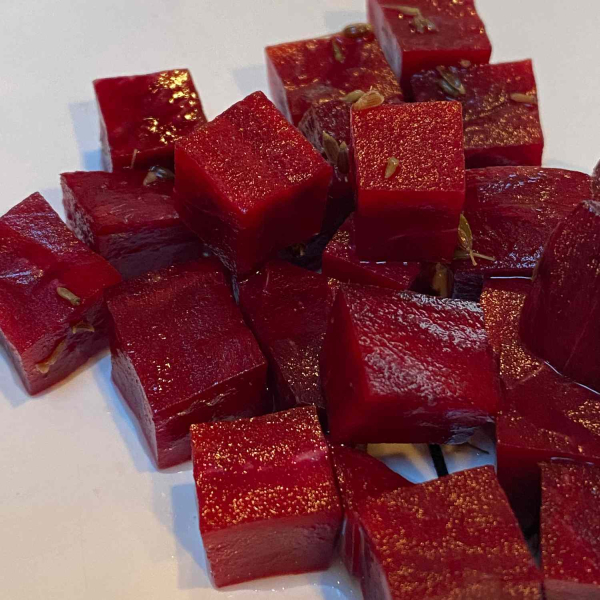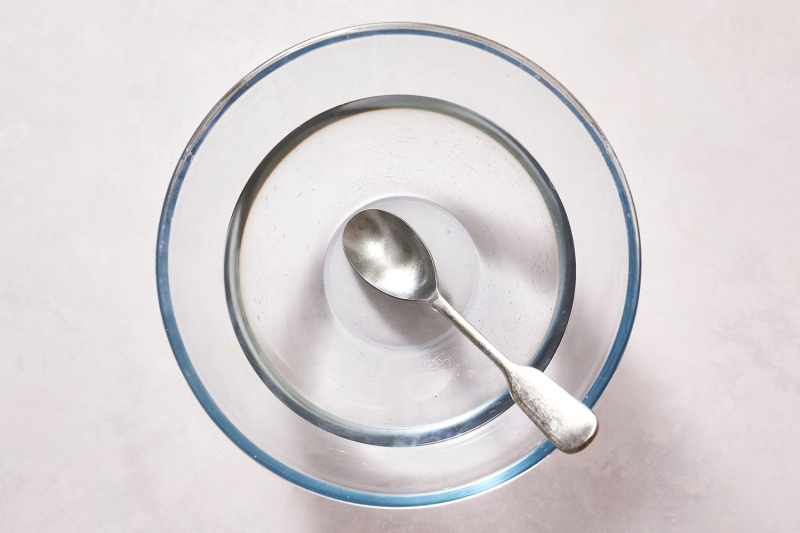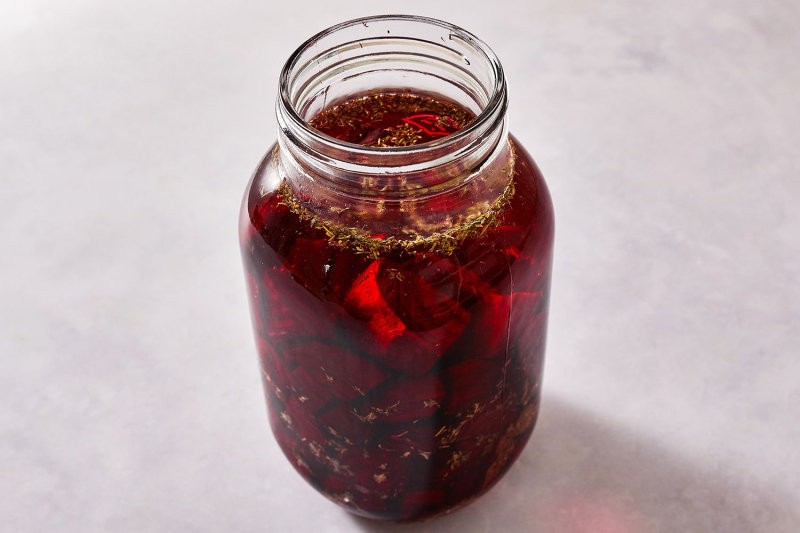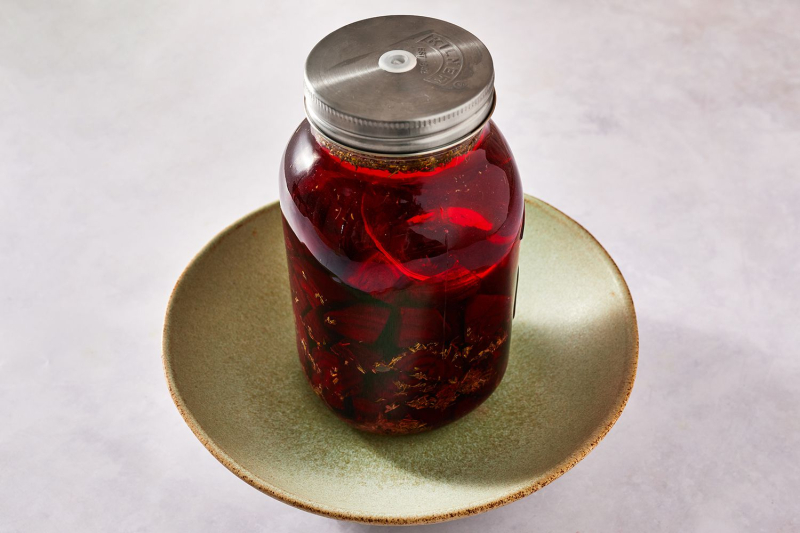Prep: 20 mins
Cook: 0 mins
Fermentation Time: 168 hrs
Total: 168 hrs 20 mins
Servings: 8 to 10 servings
Yield: 5 cups
Long before home canning, fermentation was the way people preserved foods. Fermentation gives us delicious, pungent foods like sauerkraut and kimchee, funky, sometimes stinky foods like cheeses, yogurt, and sourdough, and beverages like kombucha, wine, and beer. Chances are, some of your favorite foods and drinks are fermented.
Fermenting at home is an easy, economical, and rewarding way to preserve vegetables. These fermented beets are pleasantly sour and earthy tasting, and the process couldn't be more straightforward. All you need is a large canning jar, beets, some salt, filtered water, and whatever flavor additions you like. This version includes a simple combination of peppercorns, garlic, and thyme, but feel free to use any complementary combination of whole spices and herbs.
Some equipment—airlock lids, weights, specialty jars—makes fermentation easier, but for the occasional jar or two of fermented vegetables, you can get by with items you have on hand. To successfully ferment, you must provide an anaerobic environment, or an environment without oxygen, which means you must fully submerge the food in the brine or liquid. You’ll need something to weigh the beets down and keep them under the brine and a lid that will allow air to leave the jar but not enter. You can improvise with a small plastic bag filled with some extra brine for the weight. For a makeshift lid, secure a piece of cloth over the jar with a rubber band, or screw the lid on loosely and remove it periodically.
It takes about 1 week to ferment beets—the brine will appear cloudy as fermentation proceeds, then it will clear after about a week. Once the brine is clear, place a lid on the jar. Fermented beets are best stored between 32 F and 50 F for 1 to 2 months. The refrigerator is ideal.
“The tangy-salty fermented beets are delicious, well worth waiting a week for. You can use your dishwasher to sterilize the jars, tools, lids, and equipment. Be sure to store the fermented beets in the refrigerator and that the beets are always fully submerged in their brining liquid.” —Diana Andrews

A Note From Our Recipe Tester Cook Mode (Keep screen awake)
Ingredients
-
1 1/2 pounds beets, about 2 large
-
2 to 3 cups room temperature filtered water, non-chlorinated
-
2 tablespoons kosher salt or sea salt (not iodized)
-
3 to 4 teaspoons dry thyme
-
1 to 2 garlic cloves
-
5 peppercorns
Steps to Make It
-
Gather the ingredients. Make sure your hands, jars, tools, and work surface are clean. Learn how to sterilize your jars, here.

-
Scrub the beets, then cut off the tops and root ends. You can peel them, if desired. Cut the beets into 1/2-inch dice or chunks, or cut them into 1/4-inch thick slices.

-
Combine the water and salt in a large measuring cup; stir to dissolve.

-
Pack the beets, thyme, garlic, and peppercorns in a wide-mouth quart-size mason jar or 2 (1-pint) jars, leaving at least 1 to 1 1/2 inches of headspace to allow for the weight.

-
Add enough of the salted water to cover the beets completely. Add a fermentation weight or another weight. Place a lid on the jar. If you don't have an airlock lid, secure a square of cheesecloth on the jar with a rubber band. Alternatively, screw the lid on loosely and unscrew it periodically to let out any air.

-
Place the jar on a baking sheet, shallow bowl, or pie plate to catch any spills or juice that might bubble over. Place the jar in a cool, dark place. When fermentation is underway, the brine may appear cloudy—it will clear after about 1 week or when fermentation is complete.

-
Store fermented beets refrigerated with a tight-fitting lid from 1 to 2 months. Be sure the beets remain completely submerged in their brine when refrigerated.

Food Safety
Fermented vegetables can be safer than raw vegetables because the acid environment destroys harmful bacteria. Be sure the beets ferment in a cool, dark environment. Transfer to the refrigerator as soon as the beets have fermented. Here are some other tips to keep your fermented food safe.
- It is essential to keep the food submerged in the brine to ferment safely and successfully.
- Wash the vegetables, your hands, work surfaces, containers, and tools.
- Vegetables should be at optimum freshness.
- Once the vegetables are fermented, handle them with care. Use clean hands and utensils, and avoid cross-contamination with other ingredients, such as raw meat or fish.
Recipe Tips
Specialized fermenting lids that will let out air and pressure but keep air out and glass fermentation weights are ideal, especially if you plan to ferment frequently, but there are a few DIY alternatives you might try.
Weights:
- A small, resealable plastic bag filled with extra brine.
- Ceramic pie weights in a small plastic bag.
- Small condiment containers, mini jelly jars, or ramekins that fit in the top of the jar.
Lids:
- Use a plastic canning jar lid. Screw it on loosely and remove it daily to "burp" the food, releasing excess air.
- Cheesecloth secured with a rubber band can work but might attract fruit flies.
Recipe Variations
One of the fun things about fermenting beets at home is customizing the flavors. Here are a few ideas for flavors and combinations:
- Add 1 stick of cinnamon and 2 to 3 whole cloves.
- Add 1/2 teaspoon of coriander seeds, 2 teaspoons grated ginger, and 2 teaspoons of grated orange peel.
- Add a bay leaf to the jar.
- Add a few sprigs of dillweed and 1 to 2 small cloves of garlic.
- Add 1 1/2 teaspoons of caraway seeds and 5 or 6 black peppercorns.
- Add 1 tablespoon of vinegar to the jar for a more pronounced pickled flavor.
- Slice a small hot pepper in half lengthwise, remove the seeds, and add to the jar with the beets. Leave the seeds in for more heat.
Add a thinly sliced carrot or shallot to the jar with the beets.
What’s the difference between pickling and fermenting?
Fermenting and pickling are both food preservation techniques. Some pickles are fermented and some fermented foods are pickled.
Pickled foods are typically submerged in an acidic solution and then heated to destroy microorganisms.
Fermentation creates an acidic environment with the breakdown of starch and sugars and relies on time rather than heat.
| Nutrition Facts | |
|---|---|
| Servings: 8 to 10 | |
| Amount per serving | |
| Calories | 32 |
| % Daily Value* | |
| Total Fat 0g | 0% |
| Saturated Fat 0g | 0% |
| Cholesterol 0mg | 0% |
| Sodium 810mg | 35% |
| Total Carbohydrate 7g | 3% |
| Dietary Fiber 1g | 5% |
| Total Sugars 5g | |
| Protein 1g | |
| Vitamin C 3mg | 16% |
| Calcium 17mg | 1% |
| Iron 1mg | 4% |
| Potassium 215mg | 5% |
| *The % Daily Value (DV) tells you how much a nutrient in a food serving contributes to a daily diet. 2,000 calories a day is used for general nutrition advice. | |


